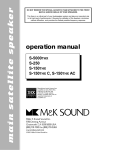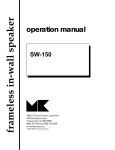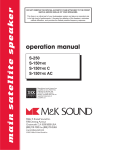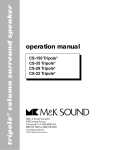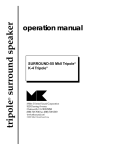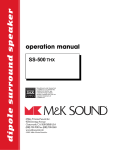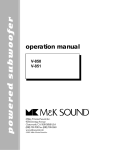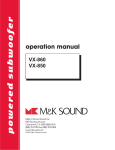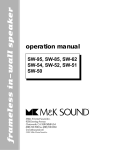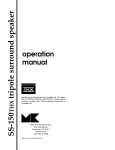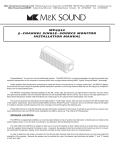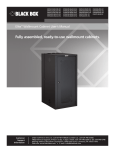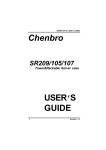Download MK Sound MP-150 Speaker User Manual
Transcript
main satellite speaker operation manual MP-150 Miller & Kreisel Sound, Inc. 9351 Deering Avenue Chatsworth, CA 91311-5858 USA (818) 701-7010 fax (818) 701-0369 www.mksound.com ©2003 Miller & Kreisel Sound, Inc. MAIN SATELLITE SPEAKER TABLE OF CONTENTS 1. 2. 3. 4. 5. 6. 7. 8. 9. 10. 11. 12. INTRODUCTION......................................................................................................3 PLACEMENT OF YOUR M&K SPEAKERS.....................................................................3 SPEAKER HOOK-UP........................................................................................................3 SPEAKER PLACEMENT IN A HOME AUDIO SYSTEM..............................................3 USING THE MP-150 AS A SURROUND CHANNEL SPEAKER..................................4 SATELLITE/SUBWOOFER PHASING TEST...........................................................5 SPEAKER DAMAGE & HOW TO AVOID IT....................................................................5 M&K WALL MOUNT BRACKETS AND STAND OPTIONS..........................................6 IF YOU NEED SERVICE.................................................................................................6 CABINET MAINTENANCE...............................................................................................6 SPECIFICATIONS..........................................................................................................7 FLUSH MOUNT BRACKET INSTRUCTIONS..................................................................7 DIAGRAMS FIGURE FIGURE FIGURE FIGURE 1 2 3 4 SPEAKER HEIGHT..............................................................................4 SPEAKER ORIENTATION.....................................................................4 M&K ST-STAND COMPONENTS.............................................................6 M&K ST-WALL MOUNT BRACKET OPTIONS.........................................6 DO NOT REMOVE THE SPECIAL ACOUSTIC FOAM ATTACHED TO THE FRONT BAFFLE OF YOUR SPEAKERS. This foam is a critical part of your loudspeaker system and plays an important role in its high level of performance. It focuses the radiation of the tweeters, minimizes cabinet diffraction, and provides the flattest possible frequency response. Please record the following information for your records: Serial Number: Date of Purchase: Dealer Name: Dealer Address: City/State/Zip: Country: Invoice Number: 2 MAIN SATELLITE SPEAKER 1. INTRODUCTION Congratulations! Your new M&K speaker system will give you years of unmatched enjoyment and excitement while listening to your favorite musical and audio/video sources. We encourage you to read this owner’s manual, as there is a great deal of information provided here to help you get the best possible performance. If you have any questions about your speaker system, please contact your M&K dealer or call the M&K factory directly at (818) 701-7010, from 8:30 AM to 5:00 PM Pacific Time, Monday through Friday. Alternatively, you can send us an e-mail to [email protected]. 2. PLACEMENT OF YOUR M&K SPEAKERS Your M&K MP-150 loudspeakers are designed for wall mounting, using the attached hanging system. You can also mount them to the wall with an M&K ST Wall Bracket, using the threaded mounting hardware permanently mounted into the cabinet's back baffle. See section 8 on page xx for details. The wide vertical radiation pattern of the MP-150 allows it to be placed high or low on the wall for good sound coverage. When the speaker will be mounted below the listeners' ears, the angled cabinet should be oriented so that it angles up toward their ears, and when the speaker is mounted above the listeners' ears, it should be oriented to angle down. The MP-150 is magnetically shielded, which allows it to be placed close to a television monitor without distorting the picture. 3. SPEAKER HOOK-UP The sound quality that you get from your speakers can be affected by the type of speaker wire that you use to connect them. We strongly recommend using the heaviest gauge wire possible. Your special M&K 5-way binding post input terminals will directly accept wire as heavy as 4 gauge! For wire runs of up to 10 feet, 16 gauge wire is acceptable. For runs up to 20 feet, you should use a minimum of 14 gauge. For up to 30 feet, use a minimum of 12 gauge, and over 30 feet should use 10 gauge. There are a very wide variety of premium speaker cables available from a number of specialist manufacturers. We do not endorse any specific brand of premium cable, but we do recommend the highest quality cable that fits your budget. Beware, though — with cables, expensive is not always better. WIRING The Positive ( + ) lead from your amplifier or receiver should be connected to the RED ( + ) "INPUT" terminal, and the Negative ( — ) lead from your amplifier or receiver should be connected to the BLACK ( — ) "INPUT" terminal. Use only one set of terminals. Either set may be used. 4. SPEAKER PLACEMENT IN A HOME AUDIO SYSTEM The Left, Center and Right speakers should ideally all be at the same height as the television screen. Because the Center channel speaker cannot cover the screen, it will have to be placed above or below the screen. When possible, set up all three speakers at the same height. If this is not practical, try to set them up so that they are no further apart vertically than 12” in height. In other words, the bottom of the speaker the farthest from the floor should be no higher than the top of the speaker closest to the floor. See Figure 3. 3 MAIN SATELLITE SPEAKER FIGURE 1 12" max. recommended D. VERTICAL ORIENTATION FIGURE 2 The performance of your speakers is dependent on their orientation. By controlling the vertical dispersion, we limit the amount of sound that would otherwise be reflected with a time delay from the floor and ceiling (for the reasons discussed in section B above). This means the speakers should always be vertically oriented. The MP-150 is vertically oriented when its tweeters are vertically stacked (not next to each other). When vertical, the controlled dispersion is in the correct plane. If they are oriented horizontally (on their sides), listeners right or left of a direct line from the center of the speaker will hear a compromised sound quality, an irregular frequency response, as well as some other problems. See Figure 2. 5. CORRECT ORIENTATION or INCORRECT ORIENTATION or USING THE MP-150 AS A SURROUND CHANNEL SPEAKER While the MP-150 was designed primarily for use as a front channel speaker, its very high level of performance makes it a superb surround channel speaker. It can be used in combination with any other M&K main speakers, especially the S-150P, S-150, SW-150, and MP-150. The MP-150 will perform equally well in both the side and back channels of 5.1, 6.1, and 7.1 channel systems and is highly effective when used in multiple-speaker arrays. The MP-150 should be installed using the attached wall-mounting system or M&K ST Wall Brackets. The speaker should be oriented so that its front baffle is angled down, and it should be located at the listeners' ear level or above. For most listeners, the preferred location for film soundtrack reproduction is at least two feet above the listeners' heads. For 5.1 channel music reproduction, some listeners prefer that the surround speakers be mounted at the same height as the front speakers. In most applications, the best overall result will be achieved with the speakers mounted above the listeners' heads. If you have any questions regarding the application of the MP-150 as a surround channel speaker, please contact the M&K factory. 4 MAIN SATELLITE SPEAKER 6. SATELLITE/SUBWOOFER PHASING TEST In any system using a subwoofer separate from satellite speakers, a phasing test must be performed to insure good bass blending. This test insures optimum sound in the critical bass frequencies where your subwoofer and satellite speakers overlap. SATELLITE/SUBWOOFER SYSTEM If you own an M&K powered subwoofer, see its owner's manual for the correct procedure for matching phase between the satellites and subwoofer. Its "SUBWOOFER PHASE" switch makes this important test very easy. If your subwoofer does not have a "SUBWOOFER PHASE" switch, follow this procedure: Play a familiar CD, LP, or tape with steady, consistent bass content through your system. Listen carefully to the "midbass" region of 75 - 125 Hz. This is the part of the spectrum where electric or string basses and drums predominate. Then, reverse the Positive and Negative speaker inputs on the back of BOTH satellite speakers. You can do this at the back of both satellite speakers, or at the subwoofer's "TO SPEAKERS" terminals (certain models only), but never at both locations. The lead that was on the Positive (+) terminal should be switched to the Negative (—) terminal, and vice versa. Now listen to the same musical passage as you did earlier, concentrating on the mid-bass region. If you hear less bass, the original connections were correct. If you hear more bass, the new connections are correct. You need to perform this test because when satellite speakers are located separate from a subwoofer, each speaker is at a different distance from your ear. In some cases, the difference will be just enough so that the output from the subwoofer arrives out of phase with the output of the satellites. When this happens, that critical mid-bass is actually cancelled. You should re-do this test any time you move your speakers. 7. SPEAKER DAMAGE & HOW TO AVOID IT An important factor to consider with any loudspeaker system is the potential for speaker damage. Even though your speakers have extremely high power handling ability, they still can be damaged by relatively low powered amplifiers. While very few M&K satellites are actually returned for service, the vast majority of those returned are not for manufacturing defects. Instead, they are returned because they have been overdriven, almost always because the amplifier or receiver used was driven into clipping distortion. This damage is considered abuse, and is not necessarily covered under warranty. This clipping distortion occurs when the demands of the music are greater than the amplifier's available power. It can occur at 20 watts with a small amplifier, or at 400 watts with a large amplifier. Regardless, when this happens, the amplifier's output waveform (which usually looks like a smooth arc) is "clipped" off, exhibiting a flat top instead of the arc. This flat top contains multiples of the original amplified frequencies, sometimes at higher levels than the original signal itself. For tweeters, this can be very damaging, as this distortion is well above the audible range, where you will be unable to hear it, and where the tweeter is more vulnerable to damage. When an amplifier clips, its sound becomes harsh and grating, and a break-up is often audible in the bass frequencies. It will become uncomfortable to listen to, compared to a slightly lower volume level. When you are listening at high volume levels, be aware of the onset of clipping distortion, and turn the volume down slightly if the sound takes on the character described above. When tone controls or equalizers are used to boost frequencies, the problem occurs much more rapidly. Even a small boost of low or high frequencies can easily double the power requirement and lead to amplifier clipping at moderate levels. Therefore, you should use your tone controls judiciously, avoiding extreme boosts of the bass and treble controls, especially when you are listening at high volume levels. 5 MAIN SATELLITE SPEAKER The best way to avoid speaker damage is to use common sense. Use moderate boosts of tone controls or equalizers, at the very most. Listen carefully for any harshness and break-up, especially at high volume levels, and turn down the volume when needed. If you cannot get enough volume, you may need to consider a higher-powered amplifier. If you have any questions about this, please contact M&K or your local M&K dealer. FIGURE 4 O 12 UP 5 DOWN O 5.0" ST Tilt Bracket (order as ST TILT BRKT) ST Fixed Bracket - Tall (order as ST FIX TALL) O 5 UP 12 DOWN O 8. M&K WALL MOUNT BRACKET AND STAND OPTIONS ST Tilt Bracket - Short (order as ST TILT SHORT) 3.18" ST Fixed Bracket - Short (order as ST FIX SHORT) 17.5" Leg with Cover (order as ST 17 LEG) The MP-150 comes with flush wall mount brackets. Please refer to the mounting template for complete instructions. If you wish to use an adjustable bracket, we recommend using M&K’s ST series wall mount brackets or the M&K ST series stands. See Figure 4 and 5. These stands are comprised of several components. For each stand assembly, you will need the base, the leg/pipe, the leg/pipe cover, and the bracket. For additional flexibility, you may choose to have the pipe custom made to suit your specific application. 25" Leg with Cover (order as ST 25 LEG) ST-1 Base (53 lbs) (order as ST-1 BASE) 2.75" H x 12" W x 13" D 72" Leg with Cover (order as ST 72 LEG) ST-2 Base (23 lbs) (order as ST-2 BASE) 2.35" H x 9.75" W x 10.5" D FIGURE 5 WALL MOUNTING OPTIONS The use of M&K’s ST-series component stand will allow both vertical and horizontal alignment. Making the critical speaker alignment process both accurate and simple. Additionally, for even more precise aiming of the speakers, we recommend using a laser alignment too. This laser too can be ordered direct from M&K, just visit our web site for more information and ordering instructions. TILT 5 UP 12 DOWN O O ST Wall Bracket - Tilt (order as ST WALL TILT) 4.5" ROTATION If you have any questions or concerns abouting moutning the speaker, please contact you local M&K dealer or M&K directly. For more information on M&K’s full line of brackets and accessories, visit our web site (www.mksound.com) or see our “Installation Solutions Catalog”. 9. ST Wall Bracket - Fixed (order as ST WALL FIX) 4.5" ROTATION ST Corner Bracket - Tilt (order as ST CRNR TILT) IF YOU NEED SERVICE TILT 5 UP 12 DOWN O O Contact your dealer or M&K with a complete description of the problem. Please have the unit's model and serial numbers (found on the back of the cabinet), date of purchase, and your dealer's name. You can call M&K between 8:30 AM and 5:00 PM Pacific Time, Monday through Friday, at (818) 701-7010. If you call outside these hours, leave a message, and we will return your call or you can e-mail us at [email protected]. ROTATION 6.5" ST Corner Bracket - Fixed (order as ST CRNR FIX) ROTATION 6.5" DO NOT RETURN YOUR SPEAKERS TO THE FACTORY FOR SERVICE WITHOUT OBTAINING PRIOR AUTHORIZATION All M&K satellite speakers carry a ten year limited parts and labor warranty. This warranty is transferable to new owners up to three years from the date of original purchase. It does not cover abuse, misuse, repairs by unauthorized service stations, speakers with missing or altered serial numbers, and those damaged in shipping or by accident. If you have any questions about the warranty, please contact M&K Sound or your authorized local M&K dealer. 10. CABINET MAINTENANCE The MP-150's painted finish does not require any special maintenance; regular dusting with a lint-free cloth and periodic cleaning is all that is required. Matching paint can be used if necessary to repair any surface damage. 6 MAIN SATELLITE SPEAKER 11. SPECIFICATIONS MP-150 IMPEDANCE: MINIMUM POWER: RECOMMENDED POWER: MAXIMUM POWER: FREQUENCY RESPONSE: DIMENSIONS (H x W x D): WEIGHT: RECOMMENDED STANDS: BRACKETS: 12. 4 ohms 25 watts RMS amplifiers with between 50 and 400 watts RMS or more (see below) 400 watts RMS unclipped peaks 77 Hz - 20 KHz ± 2dB 12-1/8” x 10-1/2” x 5-1/2” (max D) 4-1/4” (min D) 17 lbs M&K ST-1 Base, ST-Leg/Tilt17 or ST-Leg/Tilt25 M&K ST-series wall brackets FLUSH MOUNT BRACKET Speakers at or above listeners ear level. Speakers below listeners ear level. 7 MAIN SATELLITE SPEAKER MP150 manual 09/09/2003 pt/qrk PN # 70082 8








